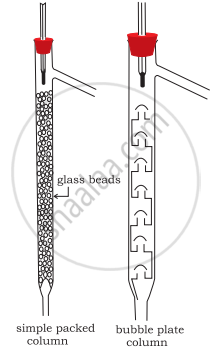Advertisements
Advertisements
प्रश्न
Draw a diagram of bubble plate type fractionating column. When do we require such type of a column for separating two liquids. Explain the principle involved in the separation of components of a mixture of liquids by using fractionating column. What industrial applications does this process have?
उत्तर
Whenever the difference in the boiling points of two liquids is not much than simple distillation technique cannot be used to separate them. The vapours of such liquids are formed within the same temperature range and are condensed simultaneously and hence the technique of fractional distillation is used in such cases. In this technique, vapours of a liquid mixture are passed through a fractionating column before condensation. The fractionating column is fitted over the mouth of the round-bottomed flask. The vapours of the liquid with higher boiling point condense before the vapours of the liquid with lower boiling point. The vapours rising up in the fractionating column become richer in more volatile components and by the time the vapours reach to the top of the fractionating column, these become rich in more volatile components.

APPEARS IN
संबंधित प्रश्न
How is distillation more advantageous than evaporation?
On what principle are the following methods of separation based? Give one example of a mixture for each of the methods mentioned in which they are used
Fractional distillation :
Write an answer to the following question in your own words.
Where are the methods of separation by distillation and by separating funnel used? Why?
Write an answer to the following question in your own words.
Which precaution will you take while using the methods of distillation and separation by separating funnel?
State the correct technique for the separation of the following mixture.
a low boiling point liquid from a high boiling point liquid.
Pure water from impure water
- Give the principle involved in the separation of the mixture
- Give the technique of separation of the mixture.
Which of the tubes in Fig. 2.1 (a) and (b) will be more effective as a condenser in the distillation apparatus?

Match the type of mixture of compounds in Column I with the technique of separation/purification given in Column II.
| Column I | Column II |
| (i) Two solids which have different solubilities in a solvent and which do not undergo reaction when dissolved in it. | (a) Steam distillation |
| (ii) Liquid that decomposes at its boiling point | (b) Fractional distillation |
| (iii) Steam volatile liquid | (c) Simple distillation |
| (iv) Two liquids which have boiling points close to each other | (d) Distillation under reduced pressure |
| (v) Two liquids with large difference in boiling points. | (e) Crystallisation |
Two liquids (A) and (B) can be separated by the method of fractional distillation. The boiling point of liquid (A) is less than boiling point of liquid (B). Which of the liquids do you expect to come out first in the distillate? Explain.
Explain the factors, which will affect the rate of evaporation, taking examples from our daily life experiences.
